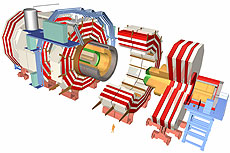Upgrades workshop envisions the future of CMS
experiments
 |
|
A sketch of the CMS detector. Image courtesy of the CMS collaboration.
|
On Oct. 30, scientists at CERN switched off the proton beams for the Large Hadron Collider. The completed 2011 run outdid all expectations, especially for luminosity, and provided the collider's four experiments with an unprecedented amount of data.
When the proton running resumes in 2012, the accelerator's beam energy will continue at 3.5 TeV. CERN is on track to double the energy in 2015, with the luminosity expected to rise as well. For the CMS detector to keep up with this progress, upgrades are required. To develop plans for the detector upgrades, an international community of CMS physicists gathered earlier this month for their largest Fermilab workshop so far.
"The machine did better than anybody expected," said Joel Butler, the operations program manager for US CMS. "This is a wonderful thing, but it also provides a challenge for us to get ready."
Higher beam energy and luminosity at the LHC translates to a higher intensity of particles bombarding the CMS detector components. The accumulation of exposure to the particles results in a loss of efficiency for the inner-most detector instruments. This new level of scientific analysis is pushing the design limits of the current detector. Butting up against those limits puts pressure on scientists today to envision the physics for years to come and to invent the technology needed to get there.
"Part of the problem is we don't know what physics is going to be the most interesting at that time," said Harry Cheung, a Fermilab physicist and one of the workshop organizers.
Another challenge is to simultaneously seed the future while harvesting the present, said Rick Cavanaugh, an assistant professor of physics at the University of Illinois at Chicago and a CMS physicist collaborating on the upgrades.
"We are probing nature to the smallest fundamental scales ever probed by mankind. This is a huge time for science," Cavanaugh said.
Building on the excitement and knowledge gained by analyzing the current high quality CMS datasets, the interest in upgrading detector components to cope with much higher beam intensities is now growing to fever pitch. Reflecting this, the CMS workshop had an excellent turnout, with about 155 attendees filling the meeting rooms and occasionally spilling into the outside corridor.
One proposed upgrade under discussion for the CMS detector was a new pixel detector - best described as a highly-sensitive digital camera capturing the collisions, but able to capture 40 million photos per second. The pixel detector is one of the components closest to the beam pipe that receives the greatest bombardment of particles from the proton-proton collisions and will be replaced in the first phase of upgrades.
The CMS scientists plan to begin the first phase of upgrades in 2015. A second phase will begin in 2020, with upgrades installed around 2022 and designed to last until 2030 - a long way off for this type of rapidly-evolving science.
"If you don't plan for the future now, by the time the future comes it's too late," Cavanaugh said. "It takes many years to design, develop and commission these very sophisticated detectors."
—Brad Hooker
|